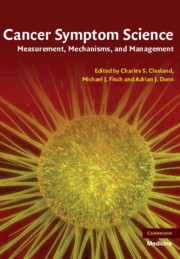Book contents
- Frontmatter
- Contents
- Contributors
- Foreword
- Credits and acknowledgements
- Section 1 Introduction
- Section 2 Cancer Symptom Mechanisms and Models: Clinical and Basic Science
- 4 The clinical science of cancer pain assessment and management
- 5 Pain: basic science
- 5a Mechanisms of disease-related pain in cancer: insights from the study of bone tumors
- 5b The physiology of neuropathic pain
- 6 Cognitive dysfunction: is chemobrain real?
- 7 Cognitive impairment: basic science
- 8 Depression in cancer: pathophysiology at the mind-body interface
- 9 Depressive illness: basic science
- 9a Animal models of depressive illness and sickness behavior
- 9b From inflammation to sickness and depression: the cytokine connection
- 10 Cancer-related fatigue: clinical science
- 11 Developing translational animal models of cancer-related fatigue
- 12 Cancer anorexia/weight loss syndrome: clinical science
- 13 Appetite loss/cachexia: basic science
- 14 Sleep and its disorders: clinical science
- 15 Sleep and its disorders: basic science
- 16 Proteins and symptoms
- 17 Genetic approaches to treating and preventing symptoms in patients with cancer
- 18 Functional imaging of symptoms
- 19 High-dose therapy and posttransplantation symptom burden: striking a balance
- Section 3 Clinical Perspectives In Symptom Management and Research
- Section 4 Symptom Measurement
- Section 5 Government and Industry Perspectives
- Section 6 Conclusion
- Index
- Plate section
- References
15 - Sleep and its disorders: basic science
from Section 2 - Cancer Symptom Mechanisms and Models: Clinical and Basic Science
Published online by Cambridge University Press: 05 August 2011
- Frontmatter
- Contents
- Contributors
- Foreword
- Credits and acknowledgements
- Section 1 Introduction
- Section 2 Cancer Symptom Mechanisms and Models: Clinical and Basic Science
- 4 The clinical science of cancer pain assessment and management
- 5 Pain: basic science
- 5a Mechanisms of disease-related pain in cancer: insights from the study of bone tumors
- 5b The physiology of neuropathic pain
- 6 Cognitive dysfunction: is chemobrain real?
- 7 Cognitive impairment: basic science
- 8 Depression in cancer: pathophysiology at the mind-body interface
- 9 Depressive illness: basic science
- 9a Animal models of depressive illness and sickness behavior
- 9b From inflammation to sickness and depression: the cytokine connection
- 10 Cancer-related fatigue: clinical science
- 11 Developing translational animal models of cancer-related fatigue
- 12 Cancer anorexia/weight loss syndrome: clinical science
- 13 Appetite loss/cachexia: basic science
- 14 Sleep and its disorders: clinical science
- 15 Sleep and its disorders: basic science
- 16 Proteins and symptoms
- 17 Genetic approaches to treating and preventing symptoms in patients with cancer
- 18 Functional imaging of symptoms
- 19 High-dose therapy and posttransplantation symptom burden: striking a balance
- Section 3 Clinical Perspectives In Symptom Management and Research
- Section 4 Symptom Measurement
- Section 5 Government and Industry Perspectives
- Section 6 Conclusion
- Index
- Plate section
- References
Summary
Sleep is a fundamental biological process that is as important to survival as are eating and breathing. We now know that adequate sleep is essential for physical and mental health. Yet, the precise functions of sleep – what sleep does for the brain and body – remain elusive. The relationship among cancer, sleep disruption, and sleep disorders is discussed inChapter 14. The focus of this chapter is basic sleep mechanisms that can lead to cancer-related sleep disturbances, particularly those mechanisms that may be susceptible to perturbation during pathology.
Sleep consists of two major phases, rapid-eye-movement (REM) sleep and non-REM (NREM) sleep. In human sleep research and in sleep-disorders medicine, the NREM sleep phase is further subdivided into three stages that may generally be considered to parallel a continuum of sleep depth: stage N1 is the light sleep that follows wakefulness; during stage N2, two electroencephalogram (EEG) features, spindles and K-complexes, are typically found; stage N3 is referred to as slow-wave sleep and is characterized by a preponderance of high-amplitude, low-frequency EEG components. Preclinical sleep researchers generally find it sufficient to define only the two sleep phases, REM sleep and NREM sleep, in laboratory research animals.
Healthy sleep consists of cycles of orderly transitions from wakefulness to NREM sleep to REM sleep. Healthy human adults during the course of a night's sleep will have four to six NREM–REM cycles of about 80–110 minutes duration, whereas rodents will have many NREM–REM cycles, each lasting about 8–10 minutes.
Information
- Type
- Chapter
- Information
- Cancer Symptom ScienceMeasurement, Mechanisms, and Management, pp. 170 - 178Publisher: Cambridge University PressPrint publication year: 2010
